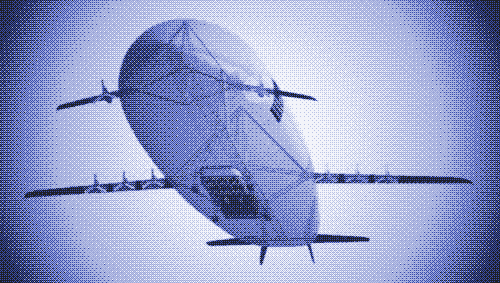
An American company, Ohio Airships, combines the advantages of air cargo while significantly reducing ecological problems. They achieve this by designing slow cargo airships, called “Dynalifters”. These air vessels mix the travel concepts of planes and Zeppelins. They can carry 3 times more freight than a Boeing 747, but travel at a speed of only 200 kilometres an hour, consuming considerably less fuel.
The vessels are designed to overcome the drawbacks of traditional airships, like ground-handling in windy conditions. The Dynalifter, unlike the Zeppelin aircraft, is not lighter than air and has an internal frame where a large fraction of its weight is carried by aerodynamic lift on the wings and hull. The airship has wheels and takes off and lands as passenger aircrafts do. The company completed 4 conceptual designs for four different sizes. All designs are equipped with detachable cargo pods for rapid loading and off-loading, and a prototype with a length of 37 metres has already been built and tested.
Air freight will keep on growing
Since the beginning of the nineties, air freight has been increasing at a rapid rate, greater than that of passenger travel. According to French business newspaper Les Echos, air cargo will keep on growing at a rate of 5.2 percent per year up till 2011.
In that year, 112 million tonnes of goods are predicted to be transported by air, compared to 78 million tonnes in 2004. At present, half of all air freight is transported in the cargo space of passenger aircraft.
Millenniumairships is working on a similar concept, an airship powered by solar energy (which means energy use can almost be reduced to zero).
It is a known fact that the least ecological means of transferring goods is by air. One reason for this is the technology itself. Aeroplanes burn immense amounts of fuel and emit more greenhouse gases than any other mode of transport.
Secondly, geographical trade behaviour dictates goods to be traded predominantly from East to West. According to Air France, for every cargo plane that travels from Europe to Asia, 8 cargo planes travel back. This means that cargo planes are flying across with empty holds, solely to collect goods a lot of the time.
Low cost transport network
It may be said that air cargo also has its ecological advantages. Unlike trucks, airplanes do not need roads. Also, they do not pollute the oceans or displace complete ecosystems through water ballast as ships do. Ohio Airships is aiming mostly at the developing world. North-America and Europe already have elaborate road systems in place, but for continents like Africa, Asia and South America, the development of an intricate road system may be expensive, and not be environmentally plausible.
To stimulate trade, the World Bank proposed upgrading the muddy African road infrastructure to a trans-African highway network that links 83 major cities and has a total length of about 100.000 kilometres. Because of their growing economies, developing countries need greater amounts of cargo transport. Trucking (or to a lesser extent rail transport) would destroy their natural environment, and would demand vast amounts of money.
The largest cost in building a rail or trucking system is not the vessels themselves, but the road or rail networks. Dynalifter poses a competitive speed to trucks and trains, minus the need for an over cluttered road or rail network to be in place. The airships only need a place to land and take off, on runways that are considerably smaller than those of traditional airports. That also means a cargo transport infrastructure could be installed much faster. According to Ohio Airships, a Dynalifter infrastructure could be developed for one tenth of the price of a conventional trucking system.
E-commerce
Ohio Airships also sees an opportunity in the developed nations; a slow air infrastructure, as a means of intermediate intercontinental parcel transport between slow shipping transport, which is cheap, and fast air transport, which is expensive. Airshipping could therefore match the needs of the e-commerce business model, which is the fastest growing trend in distribution.